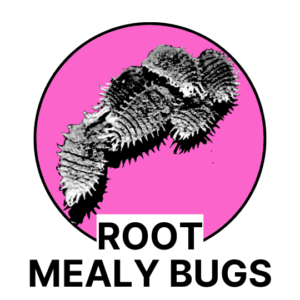
ABOUT ROOT MEALYBUGS
Root mealybugs live within the root system of plants, where they pierce the roots and suck the sap out, effectively killing the plant over time. They look very similar to the mealybugs we find in the foliage – they are round and fluffy and move slowly. They can be difficult to detect until populations are quite large because it’s not very often that we look at our plant’s roots.
The insects themselves are fairly small and are most often identified by the white fluffy debris they leave behind. This debris will cling to the surface of the plant’s roots. While root mealybugs can feed on any plant, they tend to prefer hoyas, begonias and palms.
This pest moves easily between plants – the adults lay eggs which hatch into “crawlers”, and these little ones will crawl out of the plants pot through the drainage hole and into nearby pots. This most commonly happens during watering when the crawlers can be physically washed out of the pot.
ROOT MEALYBUG DAMAGE
The only indication of root mealybugs, other than visually see them on the roots of your plants, is overall plant decline.
ROOT MEALYBUG TREATMENT
For root mealybugs, you’ll want to use a combination of rove beetles and stratiolaelaps to get rid of them. If you can, prior to beginning the beneficial treatment plan, remove the plant from its substrate, rinse the roots with warm water, throw out the substrate and replace with new substrate.
Then it is recommended to do two releases, two weeks apart of the combination rove beetles and stratiolaelaps, then continue to release stratiolaelaps every two weeks until you feel comfortable the root mealybugs are gone.
You should treat all plants preventatively in the immediate vicinity as well with the stratiolaelaps soil mite. This mite can be released on soil-less mediums as well such as pon, leca, moss etc.





